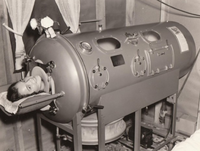








A negative pressure ventilator, often referred to colloquially as an iron lung, is a form of medical ventilator that enables a person to breathe when normal muscle control has been lost or the work of breathing exceeds the person's ability. Examples of the device include both the Drinker respirator and the Both respirator. The negative form of pressure ventilation has been almost entirely superseded by positive pressure ventilation or biphasic cuirass ventilation.
Invention History
In 1931, John Haven Emerson (February 5, 1906 – February 4, 1997) introduced and improved upon a less expensive iron lung.The Emerson iron lung had a bed that could slide in and out of the cylinder as needed, and the tank had portal windows which allowed attendants to reach in and adjust limbs, sheets, or hot packs.[9] Drinker and Harvard University sued Emerson, claiming he had infringed on patent rights. Emerson defended himself by making the case that such lifesaving devices should be freely available to all.[9] Emerson also demonstrated that every aspect of Drinker's patents had been published or used by others at earlier times. Since an invention must be novel to be patentable, prior publication/use of the invention meant it was not novel and therefore unpatentable. Emerson won the case, and Drinker's patents were declared invalid.
The United Kingdom's first iron lung was designed in 1933 by Robert Henderson, an Aberdeen doctor. Henderson had seen a demonstration of the Drinker respirator in the early 1930s, and built a device of his own upon his return to Scotland. Four weeks after its construction, the Henderson respirator was used to save the life of a 10-year-old boy from New Deer, Aberdeenshire, who was suffering from poliomyelitis. Despite this success, Henderson was reprimanded for secretly using hospital facilities to build the machine.